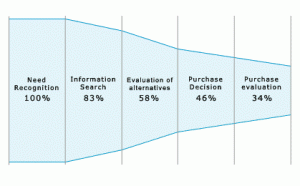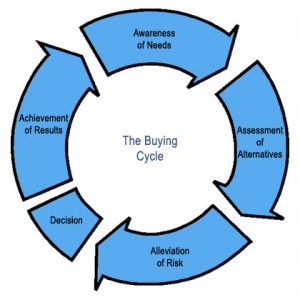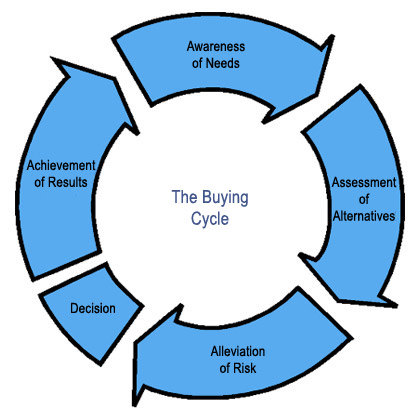DIGITAL PURCHASE PROCESS
Definition: Buying Process
A standard process that corporations and individuals progress through (in order) when purchasing a product or service. Also known as the 'Buying Cycle' or 'Purchase Process'.

The Digital Purchase Process:
This process typically consists of 5 major steps:
1. Need/Problem Recognition or Identification - This is the initial stage where an individual comes to the realization that she has a problem (or opportunity). It is only once an individual recognizes a problem that she can start looking for a solution. This stage cannot be skipped, and is always the first stage of the process. Eg. I need to hang a picture on my office wall.
2. Information Gathering/Determination of Alternatives - This is the 2nd stage of the purchase process where an individual now begins to look for solutions to their problems or to the opportunities that they've identified. There are often more ways than one to achieve the given objective.
eg. I can:
-
-
- a. merely drill a screw into the wall
-
-
-
- b. drill a hole and insert a plug for more stability
-
-
-
- c. use a laser to create a hole and insert a plug
-
-
-
- d. use an adhesive tape of some sort, and merely stick it to the wall
-
-
-
- e. do nothing
-
Role of the Internet in Stage 2 of the digital purchase process:
In terms of the internet, it dramatically improves an individuals ability to find alternatives and information about most of those alternatives. Perform a search for "hang a picture"and you'll be presented with at least 146,000 results.
3. Assessment of Alternatives/Alleviation of Risk -
The 3rd phase of the process is the Assessment of Alternatives with an eye to reduce risk, and maximize the probability the objective set forth is satisfied. The more complex and costly the possible solutions, the more questions that have to be asked and answered. Each alternative is assessed in turn.
eg.
-
-
- a. what is the likelihood that a single screw in the wall will hold the picture?
-
-
-
- b. what is the cost of replacing the picture if the screw does not hold?
-
-
-
- c. do I already have a drill?
-
-
-
- d. can I borrow a drill?
-
-
-
- e. do a have a wall plug?
-
-
-
- f. how much does a wall plug cost?
-
-
-
- g. how far will I have to drive to get the wall plug?
-
-
-
- h. how much time will it take to drive to buy a wall plug?
-
-
-
- i. what is the likelihood the wall plug won't hold the picture?
-
-
-
- j. how much is a wall drilling laser?
-
-
-
- k. do I have a wall drilling laser or can I borrow one?
-
-
-
- l. will a wall drilling laser cause the wood stud in the wall to catch fire, and what is the probability of my office burning?
-
Role of the Internet in Stage 3 of the digital purchase process:
In terms of internet marketing, potential purchasers will look for recognized brands online, or anything within a website that suggests stability and credibility such as:
-
-
- a. crests
-
-
-
- b. partnerships with recognized brands
-
-
-
- c. awards
-
-
-
- d. consumer feedback and opinion
-
-
-
- e. site quality
-

4. Purchase -
The 4th phase of the buying process is in making the actual purchase. Now that the individual has decided what alternative they will go with because it offers the best perceived combination of goal achievement and minimization of risk ... they purchase.
5. Post Purchase Evaluation -
This is the last phase of the Buying Cycle and once again it involves the individual asking themselves a series of questions, but this time the questions are designed to help the individual learn from his/her mistakes.
eg.
-
-
- a. did the purchase accomplish its objective?
-
-
-
- b. were any of the risks realized?
-
Ultimately, an individuals satisfaction with a purchase, and their likelihood of becoming a brand advocate, will be based on the perceived results relative to expectations. Did the purchase exceed their expectations, merely meet their expectations, or fall beneath expectations? If it exceeded expectations, you've got a brand advocate. If merely met, the individual is likely brand neutral. If the purchase falls below expectations, then you'll likely have a 'brand basher', spreading news of their negative experience in as many places as possible.
Role of the Internet in Stage 5 in the digital purchase process:
Once again, the internet plays a tremendous role in spreading both the brand advocate and brand basher messages. Blogging and micro-blogging (eg. Twitter) make it possible for people to share their experiences with hundreds (even thousands) of others with minimal effort. At the same time, these post purchase opinions often remain online indefinitely, leading to a sudden rise in the need for 'online reputation management' services. This of course means that a firm's 'brand message' is no longer carried by the firm ... its now carried and diseminated by their clients. So its entirely up to a company what message clients carry forward about their brand ... all they have to do is manage client expectations, so that they can be exceeded!
Images:
Videos:
News:


